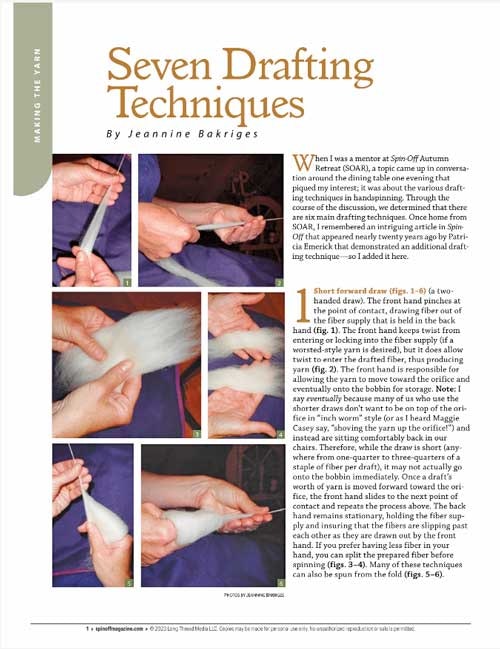When I joined the Spin Off team a few years ago, I was fortunate (and delighted!) to be able to take a class with Maggie Casey. Over the course of a few weeks, Maggie taught the basics of how to make yarn on a wheel: how to start by treadling, so it would become second nature; how to add a lead to the bobbin and then join the fiber; how to draft the fiber and add the twist and “give the yarn to the wheel.”
I borrowed a wheel so I could practice these things on my own in between weekly sessions with Maggie. But working on these things at home turned out to be much different than doing so in class. I soon became especially frustrated with the drafting element, and instead of looking forward to sitting down at the wheel, it became something I almost dreaded. Why wasn’t my fiber behaving the way it did when Maggie showed me how to draft?
Well, lots of reasons—I was pinching too tightly with my back hand that held the fiber, my hands weren’t far enough apart as I drafted, I started drafting from the wrong end of the fiber, the wheel tension wasn’t right so too much twist was being added. And how did Maggie make it look so easy to draft my yarn to a new section of fiber when it ran out? Help!
 Maggie is a very patient instructor!
Maggie is a very patient instructor!
I practiced more, asked my Spin Off team lots of questions, and over time it became easier and much less frustrating. I worked on the drafting methods Maggie taught me—woolen spun, worsted spun, over the fold. Now I’m ready to dig into even more drafting techniques. Spin Off contributor Jeannine Bakriges wrote about many more techniques in her article “Making the Yarn: Seven Drafting Techniques,” and I’m ready to dig in. How about you?
In addition to short forward draw, short backward draw, and what I only knew as the long draw, there are several more common techniques to learn, including a total of five types of long draw, with names that include words like supported, unsupported, sliding, and double drafting. Luckily Jeannine explains how to do each type, with step-by-step photos. I challenge you to try each one, or combine more than one as Jeannine suggests: “As spinners, we often mix and match techniques, don’t we? We aim to make a yarn that pleases us and is useful in whatever we choose to use it in. This is not wrong. It simply exercises our rights as thinking human beings to pull out of the hat whatever techniques we’ve learned that are helpful to make the yarn we choose to spin.”
“Making the Yarn: Seven Drafting Techniques,” by Jeannine Bakriges, is available as a free resource in the Spin Off library. And we’re regularly adding to our library, so if it’s been awhile since you’ve visited, come see what’s new!
Debbie Blair is the associate editor of Spin Off magazine. A lifelong crafter and avid reader, she finds her happy place reading and relaxing next to a mountain stream.


